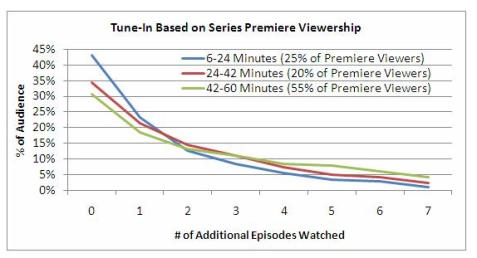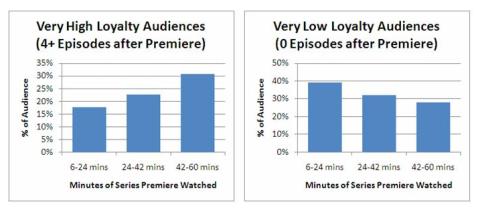Simulmedia: Series Premiere Attentiveness and Program Loyalty - Stewart Hauser - MediaBizBloggers

Close analysis of how people watch a program's series premiere reveals that viewers' likelihood of returning to future episodes follows from their attentiveness to the first. As television networks seek additional commercial vehicles to engage viewers and advertisers – think of the sponsorship model favored by PBS and championed by Rainbow Media - the link between attentiveness and loyalty increases in importance.
Attentiveness and loyalty to a program are positively correlated, as explained in an early blog post. Viewers who enjoy a show will watch a large number of minutes in a given episode and then return for future episodes, while viewers who do not enjoy the show will exhibit low attentiveness when they are watching it and will likely not return for additional episodes.
One interesting consequence of the relationship between attentiveness and loyalty is that the future viewing behavior of an important segment of a show's viewers can be predicted by simply analyzing data from a single episode, such as the series premiere. Viewers of the series premiere will return for a predictable number of future episodes based on their attentiveness to the premiere. This information could be used by advertising sales teams looking to sell sponsorships based on expected future ratings.
To further investigate these ideas, we selected several new programs on broadcast networks and divided viewers of the series premieres into groups based on the number of minutes of the premiere that they watched. For each of these series premiere attentiveness groups, we looked at the number of additional episodes watched during the season. The results support the original hypothesis of a positive correlation between attentiveness and program loyalty. The results were fairly constant across programs, and are shown for one program in the graph below:
Viewers who watch only a small portion of the series premiere are far more likely than other series premiere viewers to tune in to zero additional episodes during the season. Viewers who watch a large percentage of the series premiere, on the other hand, are much more likely than other series premiere viewers to return for a large number of additional episodes. The graphs below combine data from the several programs to summarize these observations:
One key variable to consider is the relative distribution of low, medium, and high attentiveness viewers within a series premiere or other episode. In the programs analyzed, viewers qualified for the highest attentiveness category if they watched 42-60 minutes of the hour-long premiere. On average around 55% of series premiere viewers were placed in this category. If a certain series premiere yields a high attentiveness group that is significantly larger or smaller than the 55% baseline that we have found, marketers and advertising sales teams might choose to act accordingly. A very large high attentiveness group, for example, would suggest that viewers will be unusually loyal to the program, which might mean that fewer promotions need to be run.
What is still unclear is whether marketing should be targeted toward high-attentiveness viewers or low-attentiveness viewers. Are the high-attentiveness viewers going to tune in to future episodes regardless of promotion? If so, perhaps the low-attentiveness viewers would be a better target. Further study would help clarify these questions.
Data based on a nationally-projectable DIRECTV dataset from TNS Media Research's InfoSys data product.
Stewart can be reached at stewart@simulmedia.com.
Read all Stewart's MediaBizBloggers commentaries at Simulmedia - MediaBizBloggers.
Follow our Twitter updates @MediaBizBlogger




